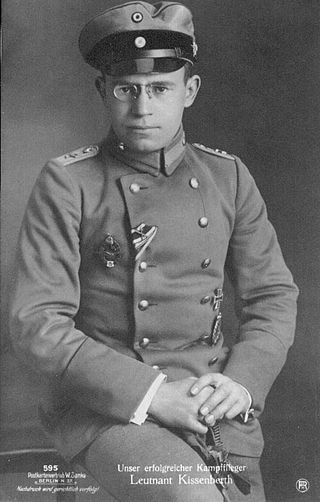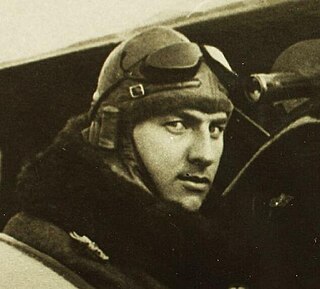Related Research Articles

Otto Kissenberth was a German flying ace of World War I credited with 20 aerial victories. He was a prewar mechanical engineer who joined the German air service in 1914. After being trained and after serving as a reconnaissance pilot, he became one of the first German fighter pilots, flying with Kampfeinsitzerkommando KEK Einsisheim. He scored six victories with this unit as it morphed into a fighter squadron, Jagdstaffel 16. His success brought him command of Jagdstaffel 23 on 4 August 1917. He would run his victory tally to 20, downing his final victim using a captured British Sopwith Camel on 20 May 1918. Nine days later, a crash while flying the Camel ended Kissenberth's combat career. His injuries were severe enough he was not returned to combat, instead being assigned to command Schleissheim's flying school. Although Otto Kissenberth survived the war, he died soon after in a mountaineering accident on 2 August 1919.
Leutnant Hans-Georg August von der Osten began his career as a World War I flying ace credited with five aerial victories. He later rose to command of all Luftwaffe bases in Germany, during World War II.

LeutnantHans Weiss was a German World War I flying ace credited with 16 aerial victories.
Hans-Georg von der Marwitz was a German World War I flying ace credited with 15 aerial victories.
OStv Johann Friedrich Reinhold Jörke was a German World War I flying ace credited with 14 confirmed aerial victories.
Leutnant Dieter Collin IC was a World War I German flying ace credited with 13 aerial victories.

Franz Xaver Danhuber was a German World War I flying ace credited with eleven aerial victories.

Leutnant Wilhelm Frickart was a World War I flying ace credited with twelve aerial victories. He is the only known German observer to become an ace balloon buster. After pilot training, he scored five additional victories, to become an ace a second time.
Willi Gabriel was a German World War I flying ace credited with eleven aerial victories. Hermann Göring removed Gabriel from combat duty for shooting four enemy airplanes contrary to orders.
Oberleutnant Franz Schleiff was a World War I flying ace credited with twelve aerial victories. Nine additional combat claims went uncredited.

Vizefeldwebel Friedrich Manschott was a German World War I flying ace credited with 12 aerial victories.
Leutnant Erich Thomas was a World War I German flying ace credited with ten aerial victories. Nine of these were observation balloons he destroyed.
Leutnant Rudolf Matthaei was a German World War I flying ace credited with ten aerial victories.
Leutnant Franz Brandt was a German World War I flying ace credited with ten confirmed aerial victories, as well as three unconfirmed claims.
Royal Prussian Jagdstaffel 74, commonly abbreviated to Jasta 74, was a "hunting group" of the Luftstreitkräfte, the air arm of the Imperial German Army during World War I. The squadron would score over 22 aerial victories during the war, including a night time victory. The unit's victories came at the expense of one pilot killed in action, one wounded in action, and one taken prisoner of war.
Royal Prussian Jagdstaffel 86, commonly abbreviated to Jasta 86, was a "hunting group" of the Luftstreitkräfte, the air arm of the Imperial German Army during World War I.
Royal Prussian Jagdstaffel 88, commonly abbreviated to Jasta 88, was a "hunting group" of the Luftstreitkräfte, the air arm of the Imperial German Army during World War I.
Royal Prussian Jagdstaffel 89, commonly abbreviated to Jasta 89, was a "hunting group" of the Luftstreitkräfte, the air arm of the Imperial German Army during World War I.
Royal Württemberg Jagdstaffel 84, commonly abbreviated to Jasta 84, was a "hunting group" of the Luftstreitkräfte, the air arm of the Imperial German Army during World War I.

Royal Prussian Jagdstaffel 81, commonly abbreviated to Jasta 81, was a "hunting group" of the Luftstreitkräfte, the air arm of the Imperial German Army during World War I. The squadron would score six or more aerial victories during July/August 1917, while serving on the Eastern Front. After switching to the Western Front, Jasta 81 would score another 35 victories from May 1918 to war's end. The unit's victories came at the expense of five killed in action, three killed in flying accidents, one injured in a flying accident, three wounded in action, and three taken prisoner of war.
References
- Above the Lines: The Aces and Fighter Units of the German Air Service, Naval Air Service and Flanders Marine Corps 1914 - 1918 Norman L. R. Franks, et al. Grub Street, 1993. ISBN 0-948817-73-9, ISBN 978-0-948817-73-1.